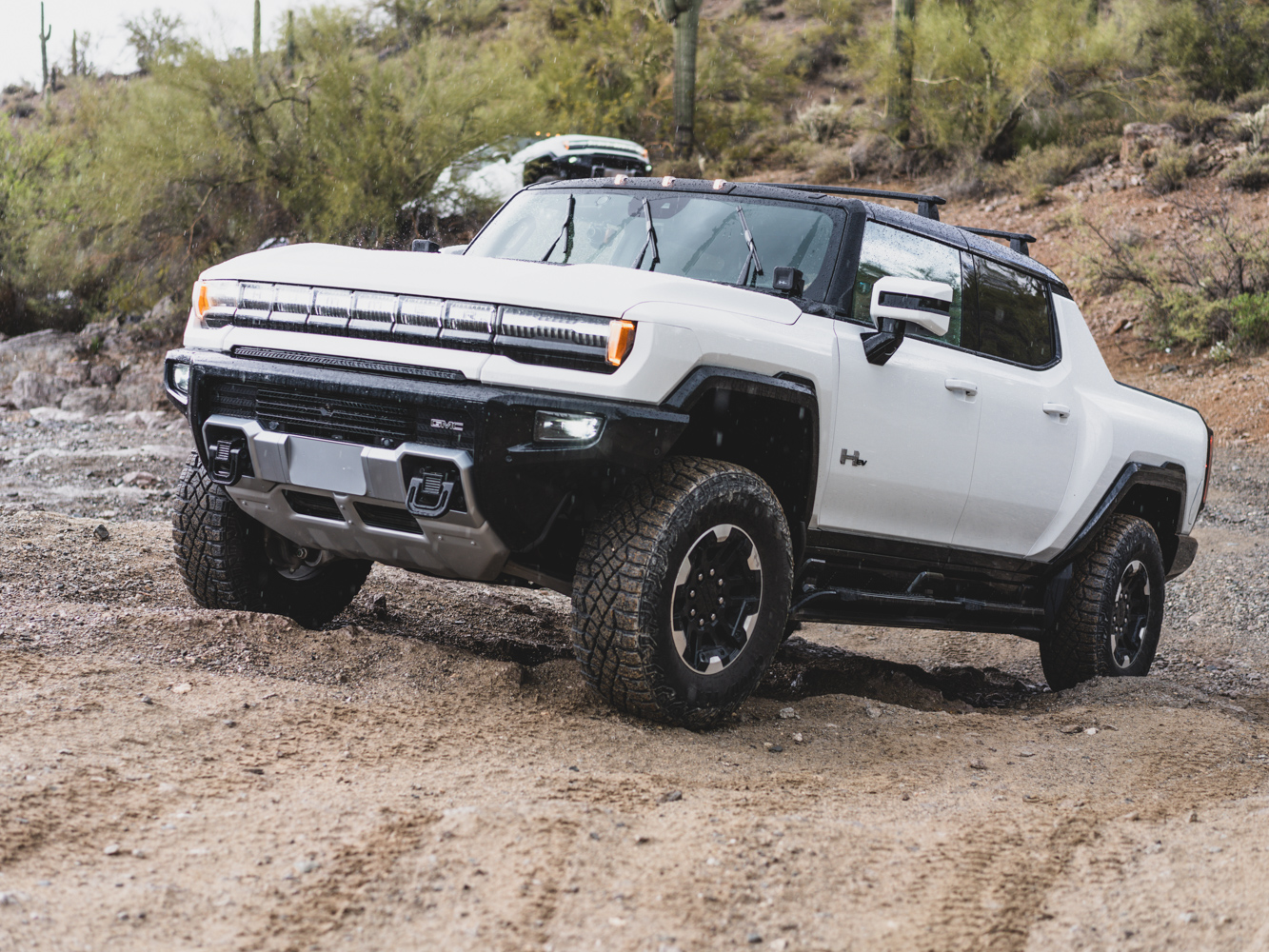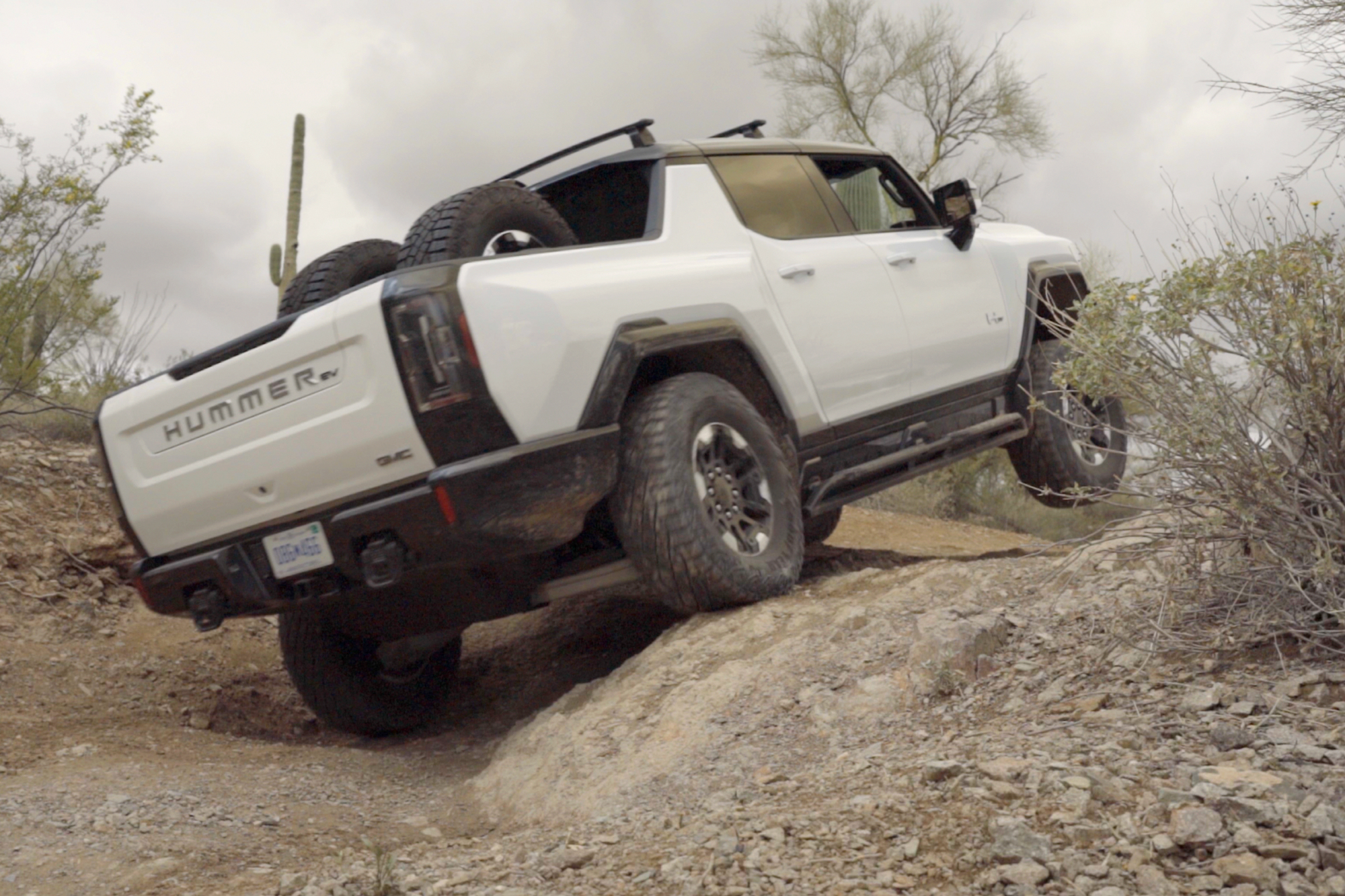The GMC team calls the new HUMMER EV a Supertruck, and the moniker is no doubt fitting. The vehicle boasts unimaginable specifications for a high-clearance 4WD, like 0 to 60 in 3 seconds, 11 second quarter mile, and 1,000 horsepower from three electric motors. For off-highway travel, the numbers get even more impressive, with 13 inches of wheel travel, adjustable-height airbag suspension, four wheel steering, crab mode, 35 inch tall tires, boron skid plates, a rear virtual locker, and a front electro-mechanical locker.

Last October, I was fortunate to be one of the first to drive the new Hummer EV, and shared detailed insights on the ride, handling, and performance characteristics of the vehicle during my time at the Milford test facility. The deep dive can be found here: Electric Super Truck :: First Off-Road Drive. Matt Swartz, our Senior Editor also penned his impressions and a deep dive into features, electronics, and drivability, which you can find on the home page.
Off-Road
Since my testing of the engineering units last year, I have come to some additional conclusions on the HUMMER. Most important, I was able to spend hours on the highway, and then a half-day on trails in Arizona. This answered some important questions around drivability in real-world conditions. On the trail, what immediately stands out is the ride quality of the independent airbag suspension, the 13 inches of wheel travel and damping effect of the bags resulting in one of the most comfortable trail rides we have experienced (slightly less plush than the new Defender), and this was at street pressures. If we could have aired down to even 25-30 psi, the overall damping and isolating effect of the 35″ tires would improve comfort even more. This is an all-day overlander.
The second thing I noticed was. . . the silence. For those reading, I can promise this is a game-changer for enjoying a day on the trails. All you hear is a light hum and the crunch of tires on the dirt. You hear the wind, you hear the birds, and most important you can enjoy a low-volume conversation with your fellow travelers. The animals also seemed to appreciate it too, with a javalina (Tayassu tajacu) meandering by, busy munching on the spring flowers. I cannot overstate how positive an experience the silence was.
The terrain we traveled was mild for the Hummer, but would be a workout for most standard pickups, with lo0se climbs and deep cross-axle holes. It would even be a workout for the paint on the Hummer if it didn’t have fourwheel steering, which was the other game-changer discovered on the trail. It is not a gimmick, and made it possible for a massive vehicle to drive Jeep trails and through tight washes without the slightest issue-it also saved most of the desert pin striping. We even watched crab walk used in a practical way, when one of the Hummers was high-centered on a rock, and they simply drove sideways off it.

As an Overlander
We spent nearly two days with the Hummer EV, including a violently fast launch to 60mph in just over three seconds. For a driver, the truck is best described a unicorn, a vehicle that is entirely practical as a daily driver, smile producing with the accelerator, and equally suitable as an overlander. The technology all works, and comes across seamlessly to the operator. For example, if your overland travels include a long road trip, set the SuperCruise and be amazed how the Hummer stays centered in the lane, and then even activates the turn signal and overtakes a vehicle. A feature like this significantly reduces driver fatigue and will no doubt improve safety for everyone on the roads (let’s be honest, most drivers are already not paying attention). It is comfortable, with most of the noise coming from the tires, because the motors are essentially silent.
The interior of the Hummer is full-size truck spacious, and packed with all the cooling, heating, and gadgetry you could ever wish for. There is also loads of space in the rear seat for camping gear, recovery gear, and tools (what tools would you bring along? Grin) The bed is bigger than it looks, but the dual spare mounts should be avoided for the traveler. My only gripe around the bed is the angle from the roofline to the bedline, which robs bedrail length, and is the one style queue I find unappealing. Maybe it serves some critical structural or aero function, but it makes the upscale Hummer look way more Avalanche than it should. Practically, that attribute also cramps some overland utility, making it more difficult to fit a slide in or wedge-style camper. No doubt someone will figure it out, and that will add a lot to the package for use in the wild.
I am not going to leave the elephant in the room unnoticed, so let’s talk about range. Personally, I believe the range anxiety comes from that same part of the hypothalamus as buying a snorkel. You don’t really need a snorkel, and range really isn’t a problem, but it does seem important to fret over. Certainly, there is some obscure and intentionally circuitous route in the USA that will create a range problem for the Hummer, but most overland travelers don’t drive 300+ miles in a day, and there are no 300 mile uninterrupted dirt routes in the USA. 99% of adventure motorcycles don’t have a 350 mile range, yet they are used to overland every day without anxiety. We left our hotel in central Phoenix and drove an hour to the trailhead, then spent over four hours driving on the dirt, followed by another hour drive back to the hotel, and still had over half the battery charge remaining. The Hummer EV wont be able to cross the Canning Stock Route (yet), but it will easily travel 90% of the overland routes we all enjoy- and it doesn’t need a snorkel either.
$112,000 as tested | gmc.com
Pros:
Shocking acceleration
Excellent ride quality on road and off
Excellent low speed and high speed dirt performance
The silence of EVs on the trail
Cons:
Angle of the cab restricts bed utility (for a camper, etc)
Needs front locker control without one pedal mode
Shallow brake travel limits modulation with left foot braking



